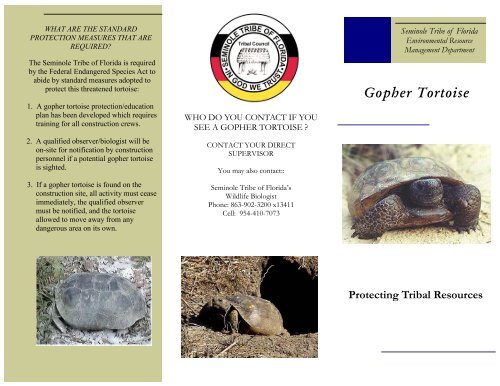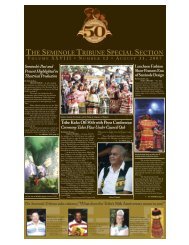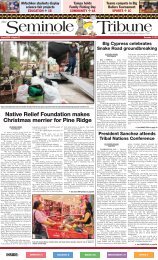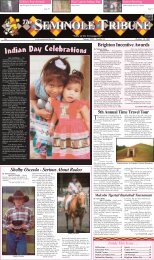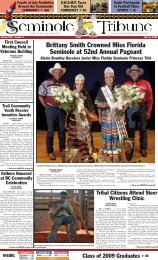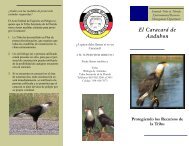Gopher Tortoise Brochure - Seminole Tribe of Florida
Gopher Tortoise Brochure - Seminole Tribe of Florida
Gopher Tortoise Brochure - Seminole Tribe of Florida
You also want an ePaper? Increase the reach of your titles
YUMPU automatically turns print PDFs into web optimized ePapers that Google loves.
WHAT ARE THE STANDARDPROTECTION MEASURES THAT AREREQUIRED?The <strong>Seminole</strong> <strong>Tribe</strong> <strong>of</strong> <strong>Florida</strong> is requiredby the Federal Endangered Species Act toabide by standard measures adopted toprotect this threatened tortoise:1. A gopher tortoise protection/educationplan has been developed which requirestraining for all construction crews.2. A qualified observer/biologist will beon-site for notification by constructionpersonnel if a potential gopher tortoiseis sighted.3. If a gopher tortoise is found on theconstruction site, all activity must ceaseimmediately, the qualified observermust be notified, and the tortoiseallowed to move away from anydangerous area on its own.WHO DO YOU CONTACT IF YOUSEE A GOPHER TORTOISE ?CONTACT YOUR DIRECTSUPERVISORYou may also contact::<strong>Seminole</strong> <strong>Tribe</strong> <strong>of</strong> <strong>Florida</strong>’sWildlife BiologistPhone: 863-902-3200 x13411Cell: 954-410-7073<strong>Seminole</strong> <strong>Tribe</strong> <strong>of</strong> <strong>Florida</strong>Environmental ResourceManagement Department<strong>Gopher</strong> <strong>Tortoise</strong>Protecting Tribal Resources
WHAT IS A GOPHERTORTOISE?WHAT DO THEIR BURROWS LOOKLIKE?WHY ARE GOPHER TORTOISESIMPORTANT?<strong>Gopher</strong> tortoise burrows provide homes forover 360 various species, including the Federallythreatened Eastern indigo snake. Additionallythe gopher tortoise is a culturally importantspecies to the <strong>Seminole</strong> <strong>Tribe</strong> <strong>of</strong><strong>Florida</strong> and is therefore identified as a speciesthat is to be conserved under theirwildlife management plan.Land turtleHerbivore; eats only vegetationAverages 9-11 inches in lengthCharacteristic stumpy, elephant-likehind feet and flattened, shovel-likeforelimbs adapted for diggingOblong shell; generally a tan, brown,or gray colorLive in sandy dry upland areasDig burrows up to 15 feet longwhich are also used by other species<strong>Gopher</strong> tortoises are listed as athreatened species bythe State <strong>of</strong> <strong>Florida</strong> due to the rapiddecline in numbers resulting fromdevelopment and loss <strong>of</strong> habitat.Frequently the tortoise itself will not be seen,however, you may tell if a gopher tortoiselives in the area by identifying their burrows.Mound <strong>of</strong> lighter colored sand at the entrancecreated when the tortoise excavatesits burrowThe top <strong>of</strong> the burrow will have a halfmoon appearance and the bottom may beflat which is also the shape <strong>of</strong> the tortoiseDebris can <strong>of</strong>ten cover the entrance to anactive burrowBurrows can be well hidden: under roots<strong>of</strong> vegetation and among vinesWHAT SHOULD YOU DO IF YOU SEE AGOPHER TORTOISE OR AN INDIGOSNAKE?If you encounter a tortoise, burrow, orindigo snake, avoid all contact. If you aredriving a vehicle or heavy equipment, stop,cease operation and allow the snake and/ortortoise to move out <strong>of</strong> the area. Do not harassthe snake or tortoise in any way. If youencounter an indigo snake, gopher tortoiseor burrow please contact your supervisor orthe number at the back <strong>of</strong> this pamphlet andreport the location and circumstances.


